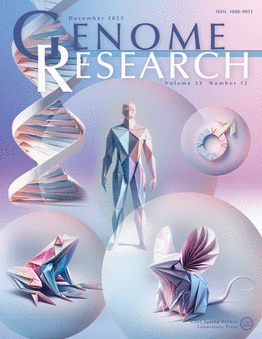针对大型进化多样性参考文献库的内存约束 k-mer 选择
IF 6.2
2区 生物学
Q1 BIOCHEMISTRY & MOLECULAR BIOLOGY
引用次数: 0
摘要
在许多生物信息学应用中,包括在元基因组序列分类中,越来越多地使用 k-mers 来寻找序列匹配。这些下游应用的准确性取决于参考数据库的密度,而参考数据库的密度正在迅速增加。虽然密度的增加带来了大幅提高准确性的希望,但可扩展性也是一个令人担忧的问题。在查询过程中,k-mers 会被保存在内存中,而保存这些不断扩大的数据库中的所有 k-mers 很快就会变得不切实际。目前已经提出了几种对 k-mers 进行子采样的策略,包括最小化和寻找特定分类群的 k-mers。然而,我们认为这些策略都是不够的,尤其是当参考集在分类学上不平衡时,大多数微生物文库都是如此。在本文中,我们探讨了如何在超大数据集中选择一个固定大小的 k-mer 子集并将其纳入文库,从而使读数分类受到的影响最小。我们的实验证明了现有方法的局限性,特别是对于新颖和采样较差的群体。我们提出了一种名为 KRANK(K-mer RANKer)的文库构建算法,它结合了多个组件,包括具有自适应大小限制的分层选择策略和公平覆盖策略。我们用高度优化的代码实现了 KRANK,并将其与对局部性敏感的哈希分类器 CONSULT-II 结合起来,构建了一种分类和剖析方法。在几个基准测试中,KRANK k-mer 选择大大减少了内存消耗,而分类准确性的损失却微乎其微。我们通过基于 CAMI 基准的大量分析表明,KRANK 在分类剖析方面优于基于 k-mer的替代方法,在准确性方面接近基于标记的最佳方法。本文章由计算机程序翻译,如有差异,请以英文原文为准。
Memory-bound k-mer selection for large and evolutionary diverse reference libraries
Using k-mers to find sequence matches is increasingly used in many bioinformatic applications, including metagenomic sequence classification. The accuracy of these downstream applications relies on the density of the reference databases, which are rapidly growing. While the increased density provides hope for dramatic improvements in accuracy, scalability is a concern. The k-mers are kept in the memory during the query time, and saving all k-mers of these ever-expanding databases is fast becoming impractical. Several strategies for subsampling k-mers have been proposed, including minimizers and finding taxon-specific k-mers. However, we contend that these strategies are inadequate, especially when reference sets are taxonomically imbalanced, as are most microbial libraries. In this paper, we explore approaches for selecting a fixed-size subset of k-mers present in an ultra-large dataset to include in a library such that the classification of reads suffers the least. Our experiments demonstrate the limitations of existing approaches, especially for novel and poorly sampled groups. We propose a library construction algorithm called KRANK (K-mer RANKer) that combines several components, including a hierarchical selection strategy with adaptive size restrictions and an equitable coverage strategy. We implement KRANK in highly optimized code and combine it with the locality-sensitive-hashing classifier CONSULT-II to build a taxonomic classification and profiling method. On several benchmarks, KRANK k-mer selection dramatically reduces memory consumption with minimal loss in classification accuracy. We show in extensive analyses based on CAMI benchmarks that KRANK outperforms k-mer-based alternatives in terms of taxonomic profiling and comes close to the best marker-based methods in terms of accuracy.
求助全文
通过发布文献求助,成功后即可免费获取论文全文。
去求助
来源期刊

Genome research
生物-生化与分子生物学
CiteScore
12.40
自引率
1.40%
发文量
140
审稿时长
6 months
期刊介绍:
Launched in 1995, Genome Research is an international, continuously published, peer-reviewed journal that focuses on research that provides novel insights into the genome biology of all organisms, including advances in genomic medicine.
Among the topics considered by the journal are genome structure and function, comparative genomics, molecular evolution, genome-scale quantitative and population genetics, proteomics, epigenomics, and systems biology. The journal also features exciting gene discoveries and reports of cutting-edge computational biology and high-throughput methodologies.
New data in these areas are published as research papers, or methods and resource reports that provide novel information on technologies or tools that will be of interest to a broad readership. Complete data sets are presented electronically on the journal''s web site where appropriate. The journal also provides Reviews, Perspectives, and Insight/Outlook articles, which present commentary on the latest advances published both here and elsewhere, placing such progress in its broader biological context.
 求助内容:
求助内容: 应助结果提醒方式:
应助结果提醒方式:


